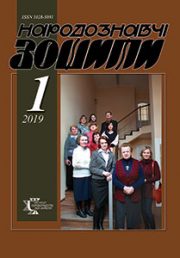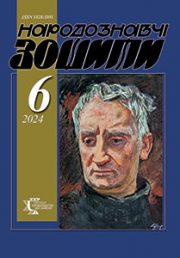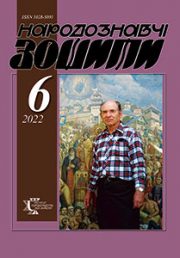2024 #3 Nakonechna T.
The Ethnology Notebooks. 2024. № 3 (177), 562—570
UDK [398.341(=161.2):633/635.054](477:292.452)
DOI https://doi.org/10.15407/nz2024.03.562
ALLOFORMS OF THE RITUAL TREE IN THE TRADITIONAL BUILDING RITUAL OF UKRAINIAN HIGHLANDERS
NAKONECHNA (HOSHCHITSKA) Tetiana
- ORCID ID: https://orcid.org/0000-0001-8596-8974
- Doctor of Philosophy, researcher fellow
- of department of Historical Ethnology
- of the Institute of Ethnology
- The National Academy of Sciences of Ukraine,
- 15, Svobody Avenue, 79000, Lviv, Ukraine,
- Contacts: e-mail: hoshchitska.tetiana@gmail.com
Abstract. Introduction: Building one’s own home in the traditional manner of ethnic groups with a long history of settlement was perceived as an extremely important milestone in the life of a family. Accordingly, the construction of a house by the Ukrainian highlanders was accompanied by a complex and diverse complex of ritual activities created over the centuries. They determined the process of choosing a «clean» place for housing, building material, erecting the main building structures, the process of entering a newly built house, etc. Problem Statement: Since the Ukrainian Carpathians, due to the specifics of the history of settlement and isolation over a long period, have become a region that has preserved a large number of relict phenomena and a lot of specific local features, it is here that you can follow such a rare phenomenon as the functioning of a construction tree not only at the stage of construction completion. Its significant research potential determines the relevance of the article. The purpose of the article is to study the place of the ceremonial tree and its semantic counterparts in the rites and customs that accompanied the construction of housing by Ukrainians in the Carpathians, to distinguish local specificity and semantics. The object of the study is the traditional building rituals of the Ukrainian Carpathians, and the subject is the functioning of the ritual tree and its alloforms in the ritual activities that accompanied the construction of housing. The scientific novelty is that such an analysis is done comprehensively for the first time. The main methods used by the author are structural, typological analysis, historical reconstruction and comparative methods. Results: From the given material, we can see that the ritual construction tree accompanied all stages of the construction of housing, lived for a long time and in a fairly wide area. Regarding its semantics, in our opinion, R. Siletskyi’s opinion that the ritual building tree is connected with a layer of archaic, pre-Christian ideas about «one’s» and «other people’s» dead, honoring ancestors and the need to involve their support. The method of manufacture (often without the use of metal objects), its appearance on the rafters and subsequent cleaning after the completion of the main works (mostly by burning or throwing it in the attic of the house) should be considered as a kind of way of «inviting» the spirits of deceased ancestors to help in such an important matter. The described mechanism of inviting and sending off ancestors is universal and has broad analogies in the calendar and family rituals of the Ukrainian highlanders and correlates with their presence of the ritual and tree and its alloforms as significant attributes.
Keywords: ceremonial tree alloforms, building rituals, folk architecture, Ukrainian Carpathians, Bojky, Lemky, Hutsuls.
Received 9.04.2024
REFERENCES
- Shukhevych, V. (1997). Hutsul’schyna (Vol. 2). Verkhovyna [in Ukrainian].
- Kajndl’, R.F. (2000). Hutsuls: their lives, customs and folk traditions. Chernivtsi: Мolodyj bukovynets’ [in Ukrainian].
- Urbanovych, B.P. (1987). Traditional beliefs and customs are associated with the construction of housing in Pokutta. FCE, 2, 52—54 [in Ukrainian].
- Warhol, N. (1992). People’s imagination about a tree. In: Scientific collection of the Museum of Ukrainian Culture in Svydnik (Issue 18, рр. 228—244) [in Ukrainian].
- Andrievska, T. (2018). Plants in the traditional rituals of the Carpathians and the adjacent Pidhirya. Fortress: collection of the reserve «Tustan» (Book 3, pp. 320—330) [in Ukrainian].
- Radovych, R. (2008). Customs and rites related to the construction of housing in the west of Galicia Boykivshchyna (based on materials from the Turkiv and Starosambir districts). The Ethnology notebooks, 3—4, 253—271[in Ukrainian].
- Radovych, R. (2020). Construction rituals of Boykivs (based on materials from the eastern and middle parts of Boykivshchyna). The Ethnology notebooks, 2, 330—349. DOI https://doi.org/10.15407/nz2020.02.330 [in Ukrainian].
- Siletskyi, R. (2011). Traditional building rituals of Ukrainians: monograph. Lviv: LNU named after I. Franko [in Ukrainian].
- Siletskyi, R. (2001). Customs and rites related to the construction of a house in the Starosambir region. Starosambirshchyna: an almanac (Vol. 1, pp. 57—62) [in Ukrainian].
- Siletskyi, R. (2008). Ceremonial building tree («wild tree») in Polissia. Bulletin of Lviv University. The series is historical (Issue 43, pp. 382—420) [in Ukrainian].
- Zyubrovsky, A.V. (2005). Field materials before topic of «Traditional architecture» from the expedition to the Starosambir district, Lviv region) 07—21.07. 2005). In: Archive of LNU named after I. Franko. F. 119. Оp. 17. Od. save 124-Е [in Ukrainian].
- Zyubrovsky, A.V. (2007). Field materials before topic of «Traditional architecture» from the expedition to the Slavutsky district, Khmelnytskyi region.) 12—18.07.2007). In: Archive of LNU named after I. Franko. F. 119. Оp. 17. Od. save 183-Е [in Ukrainian].
- Nakonechna, T. (2004). Field materials before topic of «Traditional architecture» from the expedition to the Stryjs’kuj district, L’vivs’koi area 25—30.08.2004). In: Archive of the IN NANU. F. 1. Оp. 2. Od. save 522 [in Ukrainian].
- Goshchitska, T. (2007). Field materials before topic of «Native arxitekture» from the expedition to the Starosambirs’kyj, Sambirs’kyj district, L’vivs’koi area, 16.06—16.08.2007). In: Archive of the IN NANU. F. 1. Оp. 2. Od. save 563 [in Ukrainian].
- Goshchitska, T. (2008). Field ethnographic materials on the theme «People’s construction», collected in the Skole district of Lviv region. In: Archive of the IN NANU. F. 1. Оp. 2. Od. save 576 [in Ukrainian].
- Goshchitska T. (2009). Field materials before topic of «Native arxitekture» from the expedition to the Drohobyts’kyj, Stryjs’kyj, Skolivs’kyj district, L’vivs’koi area ta Rozhniativs’kyj district, Ivano-Frankivs’koi area). In: Archive of the IN NANU. F. 1. Оp. 2. Od. save 595 [in Ukrainian].
- Nakonechna, T. (2004). Field materials before topic of «Traditional architecture» from the expedition to the Kamin-Kashirsky District, Volyn Region. 7—19.07.2004). Archive of LNU named after I. Franko. F. 119. Оp. 17. Od. save 71-Е [in Ukrainian].
- (2020). Ethnographic image of modern Ukraine. Corpus of expeditionary ethnographic and folklore materials (Vol. 9: Folk housing culture. Ecology and organization of habitat). Kyiv: IMFE [in Ukrainian].
- Miloradovich, V.P. (1991). Life and life of the Lubensk peasant. Ukrainians: folk beliefs, superstitions, demonology (Pр. 170—341). Kyiv: Lybid [in Russian].
- Baiburyn, A.K. (1983). Dwelling in rites and representations of the Eastern Slavs. Leningrad: Nauka [in Russian].
- Goshko, Yu.G., & Fedaka, P.M. (1987). Customs and beliefs related to the construction of residential and commercial buildings. In: Folk architecture of the Ukrainian Carpathians of the XV—XX centuries (Pр. 237—243) [in Ukrainian].
- Vincent, S. (2011). On a high mountain. Ivano-Frankivsk: Lileja-NV [in Ukrainian].
- Fischer, A. (1928). Rusini: outline of ethnography of Rus. Lviv; Warsawa; Krakow [in Polish].
- Hlavats’ka, L., & Dubyna, R. (2010). Interior of the house of Eastern Boykivshchyna. Echoes of the ages, 1 (12), 22—25 [in Ukrainian].
- Nykorak, O. (2003). Traditional fabrics in the customs and rites of Ukrainians. Bulletin of Lviv University. The series is historical (Vol. 38, pp. 543—567) [in Ukrainian].
- Shevchenko, L. (1926). Customs associated with the foundations of the building. Primitive citizenship and its remnants in Ukraine, 1—2, 87—95 [in Ukrainian].






